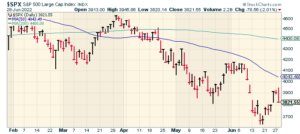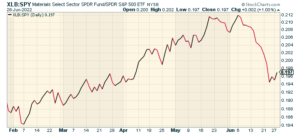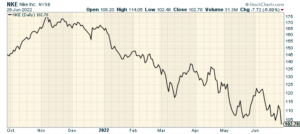CWS Market Review – June 28, 2022
(This is the free version of CWS Market Review. If you like what you see, then please sign up for the premium newsletter for $20 per month or $200 for the whole year. If you sign up today, you can see our two reports, “Your Handy Guide to Stock Orders” and “How Not to Get Screwed on Your Mortgage.”)
The Stock Market Appears to Be Calming Down
The stock market may be chilling out from its convulsions of recent weeks. That’s a welcome change. I can’t say whether this new-found calmness will last. As we know, Wall Street can change its mind on a dime.
The S&P 500 fell by 2% today, but a lot of today’s damage was in the tech sector. Here’s an interesting stat that I think sums up the recent market. Three times in the last eight sessions, the S&P 500 closed up or down by less than 0.3%. Yet in the 18 sessions prior to that, every single daily change was more than 0.3%. On Wall Street, the storms can be brutal, but they often pass quickly.

I’ve also talked a lot about the divergence between risky, highly-volatile stocks and more conservative, stable stocks. During the big market drop, those two groups were diametric opposites, and it was risky stocks feeling the most pain. Lately, however, the distance between those two groups has calmed down as well.
The market reached its recent low on June 16 when the S&P 500 closed at 3,666. While the market has recovered a little since, it hasn’t been a strong jerk to risky stocks as it’s been in previous bear market rallies.
If the market is uncertain, that’s largely due to the economic outlook also being uncertain. Tomorrow, the government will update its report on Q1 GDP. The last report said that the U.S. economy contracted at an annualized rate of 1.5% during the first three months of the year. That report led many analysts to conclude that a recession is imminent. The Atlanta Fed’s GDPNow tool expects Q2 growth of just 0.3%.
I don’t think that’s right. There were some technical reasons for why the GDP report was so low, and I don’t expect that to continue into Q2. Still, I don’t want to brush off the possibility of a recession. My disagreement is about time. I think the odds of a recession are low for right now, but a recession is very possible next year or in 2024. Higher rates from the Fed will slow things down, but it will take some time.
Consumer Confidence Falls to an 18-Month Low
Today we got some troubling economic news. Consumer confidence fell to an 18-month low. (Personally, I’d like to see this reported as consumer humility rose to an 18-month high, but that’s me.) I can’t say I’m surprised. Consumers are facing higher prices and shortages.
The consumer confidence index for June dropped to 98.7 from May’s revised reading of 103.2, which was adjusted downward by more than 3 points.
Driving down the overall level was a steep decline in consumers’ expectations for the next six months. The expectations index fell from 73.7 to a reading of 66.4 — the lowest level in nearly a decade, according to the report.
This isn’t the only bit of info suggesting that consumers aren’t happy. Last week, the University of Michigan’s Consumer Survey fell to its lowest level since they started collecting data in 1952.
I’ve also noticed a change in trends underlying the market. As I mentioned earlier, the risky stock/stable stock dichotomy has cooled down. It may have been replaced by a new dichotomy which is the gap between cyclical stocks and non-cyclicals.
Let me explain. Over the last few days, economically cyclical stocks have badly lagged the market. Energy stocks in particular have done poorly although that’s after a very robust rally this year.
But we’ve seen similar behavior in other areas. Recently, the S&P 500 Materials Index lagged the S&P 500 every day for 12 straight days. The S&P 500 Industrials only lagged for six days in a row. Financials stocks have also been sluggish.
Here’s the S&P 500 Materials ETF divided by the S&P 500 ETF:

That isn’t merely underperforming. It’s underperforming an already bad market. So what’s been leading a downward market? The answer has been healthcare and consumer staples. These stocks haven’t been doing well in an absolute sense, but they’ve been outperforming a falling market.
This suggests to me that Wall Street is also forecasting if not a full recession, then at least a period of slow growth. I should caution you that Wall Street is usually thinks about six to nine months ahead, so there’s little reason to fear the economy is hitting the skids right now.
Actually, the upcoming earnings season should be another good one. Analysts recently raised their estimates for Q2. Wall Street now sees earnings growth of 5.41%. That’s up from the prior forecast of 5.25%. (Wall Street expects profits for energy stocks to triple!)
We won’t get the next jobs report until next Friday, July 8. However, the housing market is still doing well despite higher mortgage rates. Today’s Case-Shiller report said that home prices are up 20.4% in the last year. That’s down a bit from the 12-month period ending in March.
If there is a bright spot, it’s that we’re entering the best time of year for stocks. At least, historically speaking, July and August have been great months for stocks.
A few years ago, I took the entire history of the Dow Jones Industrial Average going back to 1896. I further sliced the data to find what the Dow’s average year looks like. Historically, the summertime has been for the bulls. The Dow has rallied from June 29 until September 6. Nearly half of the Dow’s annual gain has come during that brief period.
Of course, that’s an average over a very long time period, so it shouldn’t be mistaken for a prediction. But we can say that the summer has historically been a good time for stocks.
Nike Drops 7% After Earnings — Is it a Buy?
I’m a big fan of Nike (NKE) but the stock rarely goes for an attractive price. This may be one of those rare chances.
The stock has been doing poorly for the last several months. Nike peaked at $179.10 in November. Today, it reached a 52-week low of $102.75 per share. Whenever a good stock is in the dumps, I want to take a close look.
Despite the poor performance of the stock, Nike said yesterday that it beat earnings for fiscal Q4. The sneaker folks made 90 cents per share which exceeded estimates of 81 cents per share. Sales dropped slightly to $12.23 billion, but that also topped estimates by $170 million.
What happened after Nike announced the earnings beat? The shares dropped 7% today.

Nike is facing several problems. Their business got hit hard in China by the lockdowns there. Sales in North America fell by 5%. Nike is trying to alter its business by selling more directly to consumers while bypassing wholesalers. Last quarter, direct sales rose by 7% while wholesale sales fell by 7%.
One problem area is that Nike’s inventory rose by 23% last quarter. Some of that is due to the supply chain problems. The CFO said they’re not seeing “signs of a pullback” from consumers. Nike is also facing higher costs and longer shipping times, just like everybody else.
The stat that I’m watching is Nike’s gross margin. That fell last quarter to 45%. Wall Street had been expecting 46.6%. When you lose your gross margin, that tells you that you have a problem with pricing. Part of the gross margin erosion is a result of the weakness in China. I’d include problems with logistics and freight costs.
Nike said they expect fiscal Q1 sales to be flat to up slightly. They said they expect full-year revenue growth in the low double digits. That’s not that good.
One analyst described the report as “messy.” That sounds about right. Nike also has the problem that other companies had in that their products were popular during Covid, but now there’s less of a need to buy Nikes again. Still, Nike’s business in doing well in Latin America, Europe and the Middle East.
I was most impressed that Nike announced an $18 billion share buyback program over four years. That’s a clear vote of confidence from management. Nike has a market value of roughly $162 billion. It may also suggest that Nike is near the end of its large-scale reinvestment program of the last several years.
Going into the earnings report, Wall Street had expectations that were simply too high. There have been several price target cuts in the last 24 hours. Nike closed today at $102.78 per share. Wall Street expects earnings for the current fiscal year of $4.28 per share. That’s followed by $5.06 and $5.96 for the fiscal year ending in May 2025. Bear in mind that Nike has often traded for more than 30 times trailing earnings.
I’m calling Nike a cautious buy right now. There are certainly some problems with its business, but they’re fixable. Nike has one of the strongest brand names in the world. Six months from now, Nike might be a candidate for our Buy List.
Bear markets are unpleasant, but if you’re patient, at least they can give you some bargains.
That’s all for now. I’ll have more for you in the next issue of CWS Market Review.
– Eddy
P.S. Two quick items.
I recently had a fun chat with Michael Gayed. You can listen to it here.
Don’t forget to sign up for a premium subscription: $20 per month or $200 for the whole year!
Posted by Eddy Elfenbein on June 28th, 2022 at 7:56 pm
The information in this blog post represents my own opinions and does not contain a recommendation for any particular security or investment. I or my affiliates may hold positions or other interests in securities mentioned in the Blog, please see my Disclaimer page for my full disclaimer.
- Tweets by @EddyElfenbein
-
-
Archives
- May 2024
- April 2024
- March 2024
- February 2024
- January 2024
- December 2023
- November 2023
- October 2023
- September 2023
- August 2023
- July 2023
- June 2023
- May 2023
- April 2023
- March 2023
- February 2023
- January 2023
- December 2022
- November 2022
- October 2022
- September 2022
- August 2022
- July 2022
- June 2022
- May 2022
- April 2022
- March 2022
- February 2022
- January 2022
- December 2021
- November 2021
- October 2021
- September 2021
- August 2021
- July 2021
- June 2021
- May 2021
- April 2021
- March 2021
- February 2021
- January 2021
- December 2020
- November 2020
- October 2020
- September 2020
- August 2020
- July 2020
- June 2020
- May 2020
- April 2020
- March 2020
- February 2020
- January 2020
- December 2019
- November 2019
- October 2019
- September 2019
- August 2019
- July 2019
- June 2019
- May 2019
- April 2019
- March 2019
- February 2019
- January 2019
- December 2018
- November 2018
- October 2018
- September 2018
- August 2018
- July 2018
- June 2018
- May 2018
- April 2018
- March 2018
- February 2018
- January 2018
- December 2017
- November 2017
- October 2017
- September 2017
- August 2017
- July 2017
- June 2017
- May 2017
- April 2017
- March 2017
- February 2017
- January 2017
- December 2016
- November 2016
- October 2016
- September 2016
- August 2016
- July 2016
- June 2016
- May 2016
- April 2016
- March 2016
- February 2016
- January 2016
- December 2015
- November 2015
- October 2015
- September 2015
- August 2015
- July 2015
- June 2015
- May 2015
- April 2015
- March 2015
- February 2015
- January 2015
- December 2014
- November 2014
- October 2014
- September 2014
- August 2014
- July 2014
- June 2014
- May 2014
- April 2014
- March 2014
- February 2014
- January 2014
- December 2013
- November 2013
- October 2013
- September 2013
- August 2013
- July 2013
- June 2013
- May 2013
- April 2013
- March 2013
- February 2013
- January 2013
- December 2012
- November 2012
- October 2012
- September 2012
- August 2012
- July 2012
- June 2012
- May 2012
- April 2012
- March 2012
- February 2012
- January 2012
- December 2011
- November 2011
- October 2011
- September 2011
- August 2011
- July 2011
- June 2011
- May 2011
- April 2011
- March 2011
- February 2011
- January 2011
- December 2010
- November 2010
- October 2010
- September 2010
- August 2010
- July 2010
- June 2010
- May 2010
- April 2010
- March 2010
- February 2010
- January 2010
- December 2009
- November 2009
- October 2009
- September 2009
- August 2009
- July 2009
- June 2009
- May 2009
- April 2009
- March 2009
- February 2009
- January 2009
- December 2008
- November 2008
- October 2008
- September 2008
- August 2008
- July 2008
- June 2008
- May 2008
- April 2008
- March 2008
- February 2008
- January 2008
- December 2007
- November 2007
- October 2007
- September 2007
- August 2007
- July 2007
- June 2007
- May 2007
- April 2007
- March 2007
- February 2007
- January 2007
- December 2006
- November 2006
- October 2006
- September 2006
- August 2006
- July 2006
- June 2006
- May 2006
- April 2006
- March 2006
- February 2006
- January 2006
- December 2005
- November 2005
- October 2005
- September 2005
- August 2005
- July 2005
 Eddy Elfenbein is a Washington, DC-based speaker, portfolio manager and editor of the blog Crossing Wall Street. His
Eddy Elfenbein is a Washington, DC-based speaker, portfolio manager and editor of the blog Crossing Wall Street. His